(This Retrospective article was published in the January 2007 issue of Rider.)
STORY BY CLEMENT SALVADORI • PHOTOGRAPHY BY GUIDO BURRATO
As 1952 rolled into 1953, Italy was the land of mainly single-cylinder motorcycles. A few four-cylinder machines were about, but strictly for the racetrack.
Dozens of companies made scooters and little motorbikes, like the Ducati 65 and MV Agusta 98, and there were even a couple of big 500 singles, notably the Moto Guzzi Falcone and Gilera Saturno. Several small twins were on the market, such as the Rumi two-stroke Sport 125 and the Drusiani four-stroke Comet 175, but in the main, singles were in favor. They were cheaper to make and sell, for starters; Italians needed basic transportation in the 1950s, not performance. Also, the government granted a large tax break to purchasers of small-displacement (175cc and under) machines, so there was little impetus to build larger ones.
However, this grated on all those Italian engineers whose motorcycles were winning races all over Europe. In 1952 Italian machines had won the 125, 250 and 500 world road-racing championships, Gilera taking the 500cc title with its DOHC in-line four.
As a little background, Count Giuseppe Gilera had founded his eponymous company in 1909, when he was 22, and done extremely well. So well, that in the midst of the Great Depression he bought the rights to the famous Rondine four-cylinder engine and was racing an updated version successfully after World War II.
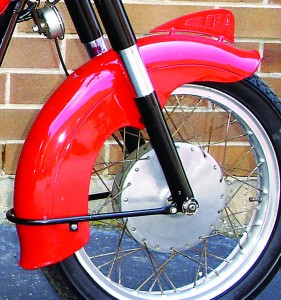
With a 500cc championship on display, Gilera decided to build a sportier utility bike. In the fall of ’52 Gilera presented its prototype of the B300, a cheerfully competent parallel twin—B for bi-cilindro, or two cylinders. Since the parallel cylinders were inclined forward 10 degrees, it could not be accused of copying the British vertical twins.
The B300 used a unit-construction engine, enclosing the four-speed transmission, a much more modern notion than having a remote gearbox. A duplex primary chain ran the power from the crankshaft to the multiplate clutch, which was bathed in oil. Bore and stroke for each cylinder was 60 x 54mm, for a total of 305.3cc. A single camshaft at the front of the engine operated the four valves, with the tried-and-true nut and screw adjusters for setting tappet clearances. The pistons rose and fell side by side in the traditional 360-degree firing fashion of parallel twins. A single 20mm Dell’Orto carburetor took the gas from the four-gallon tank, mixed it with the appropriate amount of air and fed the fuel into the cylinders, where it was compressed at a rate of 6 to 1—Italian gasoline in those post-war years was of the low-octane variety. The spent fumes passed through a pair of shiny header pipes to the rather elegant chromed mufflers. The result of all this was a claimed horsepower of 12.5 at 5,800 rpm.
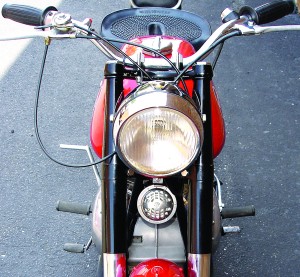
This was a workaday engine, intended for reliability rather than performance, and was mated to a modern chassis using what the Italians called a duplex “open” frame. Two steel tubes came down from the steering head to the front of the engine, with the two mid-frame tubes securing the rear. As we say today, the motor was a stressed member. The rear suspension used a swingarm with Sturcher shock absorbers; the front was a Gilera-made telescoping fork. Wheels were both 18-inchers, with a 3.00 tire on the front, 3.25 at the back, both having 6-inch single-leading-shoe full-drum brakes. Wheelbase was an abbreviated 52 inches, dry weight was a modest 303 pounds. The kickstarter was on the right side, as was the gear-shift lever.
The middling-twin prototype was received so enthusiastically that Gilera apparently accelerated the production schedule—the first ones to be sold being listed as 1954 models—with two versions available with trim and fender differences, the Normale and the Extra. Styling was very Italian, with a smoothly sculpted gas tank; a sprung solo saddle added to rider comfort, and an optional passenger pad could be affixed to the luggage rack on the rear fender. However, in the spirit of togetherness a dual seat was soon available.
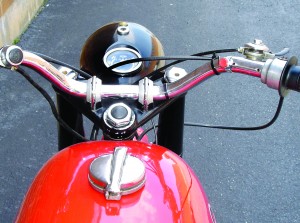
Gilera took its advertising seriously, hiring some famous Italians to promote the new machine. As a commuter the B300 was fine, but the sporting public had a few complaints, among them being that the engine ran hot and vibrated at high speeds. After a few bearing failures at high speeds, it was felt that the oiling system was a bit deficient; the factory listened. In 1957 the B300 appeared with more cooling fins, a beefier frame and improved lubrication. Also, the compression ratio was raised half a point, to 6.5:1, the carburetor was 2mm bigger and the intake valves enlarged. Now the engine was putting out 15 horses at 5,800 rpm.
Of greater note, perhaps, was the report that Gilera was pulling out of Grand Prix racing. The company had taken the 500 world title in 1953, ’54, ’55 and again in ’57. But the heir to the company, Giuseppe’s son Feruccio, had died in 1957, and the driving force behind the racing seemed to have gone with him. However, this was not just a Gilera decision, as Moto Guzzi and Mondial also announced that they were pulling out of the GP circuit. Much of this had to do with finances, as it was terribly expensive to run a race team and the sale of motorcycles in Italy was on the wane, with a Fiat 500 car being a lot more practical.
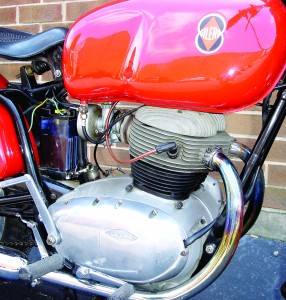
An interesting historical note is that the one company that did not pull out of racing, MV Agusta, won 64 out of the 76 GP races over the next three years.
The Gilera company continued on, and minor changes were made in the B300 for the 1964 model year. Nothing radical, just a little more compression, a bumpier camshaft and now 15.5 horsepower at 6,500 rpm, though by now the weight had gone to more than 340 pounds dry. Gilera also showed a prototype of a B500, with twin carburetors and a five-speed transmission, but that never went into production.
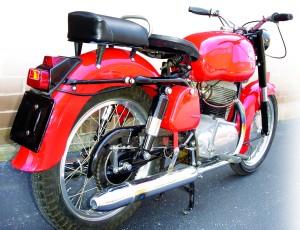
By now the Italian utility motorcycle market had been hopelessly compromised by inexpensive automobiles. Sales drooped, and the count went
looking for a buyer. In 1970 Piaggio, the maker of the Vespa scooter, bought the com- pany. A year later, at age 84, Giuseppe died; he and his motorcycles had had a good run for the money.







